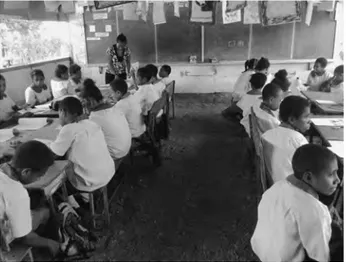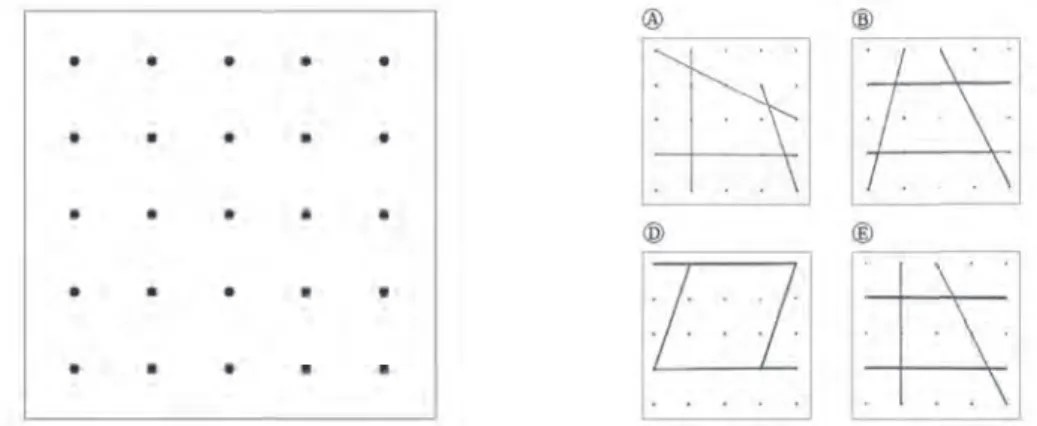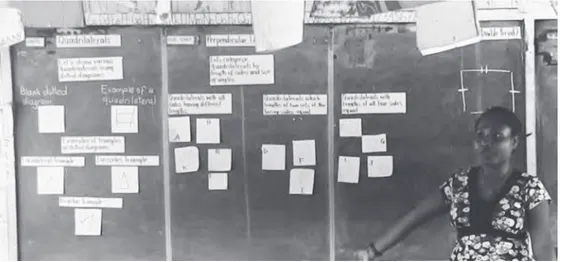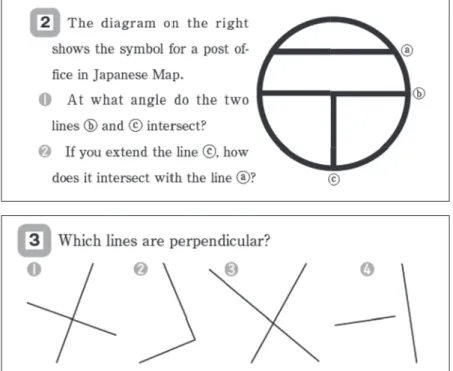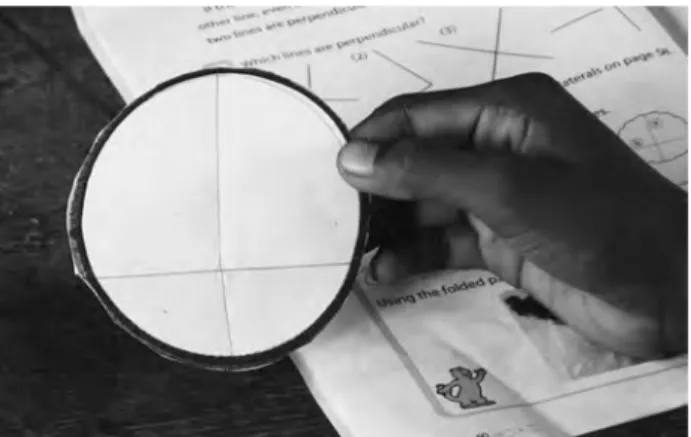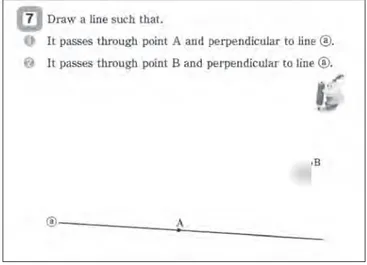Analysis of Grade 4 Mathematics Trial Lesson:
Teacher Interpretation and Teaching of the New Mathematics Textbook
David Kunum GOMAY*, Hiroki ISHIZAKA*, Takeshi SAKAI**NUE Journal of International Educational Cooperation, Volume 11, 85-94, 2017
Study Note
*
Naruto University of Education, **Kyoto Women s University
Abstract:In Papua New Guinea (PNG), change of curriculum from OBC to SBC in 2014 required the production of quality learning and teaching materials. QUISE-ME project funded by JICA developed a new mathematics textbook. Three trial lessons were conducted by the pilot teacher on Unit 6-Quadrilaterals on the Topic-of the new textbook in a Grade 4 class in a Primary School. From the fi ndings it is noted that teachers could satisfactorily interpret the textbook and organize learning activities for greater children involvement. Also, exposure to textbook could make teachers be creative and can gradually prepare child centered lessons as opposed to the current common practice of teacher centered lessons. However, the authors would recommend that 1) teachers be properly trained and benefi t in-service training, e.g., through lesson studies for them to use the textbook appropriately to develop meaningful lessons, and 2) be permitted to fl exibly decide to what extent they teach the contents of the new textbook or to just follow the fl ow of textbook and employ their own way of teaching, until they get accustomed to use it and manage well the allocated time for lessons.
1. Introduction
Mathematics is one of the very important courses of study for all children attending schools in Papua New Guinea (PNG). It is a compulsory subject studied by students from Basic Mathematics in Elementary Schools, to Primary Schools, to High Schools and Secondary Schools. Some indicators that are observed now in drop in mathematics results, misconceptions, loss of interest and motivation by both teachers and students can be attributed to curriculum reform and unavailability of textbooks for teachers and students in the PNG classroom context.
According to Apule et al., (2016), it was found that the misconceptions developed by students is carried over to the next grade level, particularly in the topic of geometry and fractions. With these misconceptions in mind, understanding higher concepts becomes much too diffi cult for them. The drop in mathematics results across all school levels in PNG for the last decade
has raised serious questions on the Outcome Based Education (OBE) that was instilled in 1996. In 2014, the curriculum changed to Standard Based Education (SBC), which was rolled out in 2015 starting from the Elementary Sector. The Curriculum change from OBE to SBC brought many challenges. One of the biggest challenges is the production of quality textbooks to be used by students to enhance learning. Under the Quality in Science and Mathematics Education (QUISE-ME) Project, the PNG Ministry of Education through the Curriculum Development Division (CDD) in collaboration with JICA, currently is writing a new mathematics textbook to be used in primary schools in PNG starting 2018.
This report contains the trialing of the New Mathematics Textbook conducted in a Grade 4 class at a Primary School in Port Moresby-Papua New Guinea. The lessons were conducted by the class teacher using the new textbook as a way to validate the contextualization of the textbook. Textbooks and
instructional materials are particularly important because they are the primary means through which students gain access to the knowledge and skills specifi ed in the State Content Standards that are at the heart of education system. (Oakes & Saunders, 2002, p.5). The understanding and interpreting of textbook by teachers is essentially important for teaching and learning to take place.
2. Research purpose and target
The Purpose of the research report is to fi nd out if the new textbook can be properly interpreted and translated into meaningful learning and teaching experiences by both students and the teachers in primary schools in Papua New Guinea. The lesson was conducted in May 2017, in a Grade 4 class at a Primary school in Port Moresby, PNG. The Total number of students in the class is approximately 34 students. There were three (3) lessons conducted in the same class by the class teacher on the Unit. One trial lesson was conducted each day during the block period, which is 80 minutes (40 minutes/lesson ×2 lessons = 80 minutes) in three (3) diff erent days. The VIDEO and photo taken by researchers were used as data. The data was analyzed qualitatively to describe the textbook contents and the three implemented trial lessons and clarify the relationship between the textbook contents and the lessons with respect to the feasibility of contextualization and issues lying on it.
The focus of the lessons was on the Unit 6: Quadrilaterals.
Lesson objectives were as follows:
1st lesson: Draw and categorize quadrilaterals by
length of sides and size of angles
2nd lesson: Understand the meaning and
characteristics of perpendicular lines
3rd lesson: Think about how to draw the
perpendicular lines
These three lessons are to understand the defi nition and meaning of perpendicular and parallel lines and to be able to draw the lines by using triangle rulers and protractor. These three lessons are an introductory part of the whole unit, which means after learning the meaning of perpendicular and parallel lines and how to draw them, the students are supposed to apply this previous knowledge for understanding the features of variety of quadrilaterals such as parallelogram, trapezoid and rhombus and how to draw them. The students are supposed to know the defi nition of right angles, how to draw straight lines and how to measure and construct angles before this unit.
Textbook structure for these 3 lessons are as follows:
1st lesson: 1) doted fi gures are on the textbook and
ask students to draw their own quadrilaterals to connect lines, which go through dots, 2) to categorize quadrilaterals students made and there are many examples on the textbook. 1st lesson
aims at connecting the concepts of lines and how to intersect them and the future defi nition of perpendicular and parallel lines and quadrilaterals. 2nd lesson: 1) fi rstly confi rm how to measure and fi nd
out relationships of lines to make a right angle, 2) introduce the defi nition of perpendicular lines, 3) confi rm the defi nition of perpendicular lines, using a Japanese post offi ce logo mark, which show possible 2 perpendicular lines, 4) give 1 exercise and activities to confi rm again the defi nition and shape of perpendicular lines.
3rd lesson: 1) Look at 3 examples of drawing
perpendicular lines and discuss about how to apply them, 2) practice to draw perpendicular lines, 3) confi rm which lines are perpendicular with a diagram.
3. Lesson description and qualitative analysis
1) 1st Lesson
In the introductory phase of the lesson, the teacher poses a verbal problem for the students to mentally calculate and respond. Problem given by the teacher was Mary was given 4 matches sticks to make a shape. How will she use the 4 matches sticks to make a box? One student said she put the sticks together, while another said she put the sticks across
then down then tied the edge. The other student was asked to draw on the black board how Mary could arrange the sticks to form the shape. Student drew a 4-side shape on the blackboard and said how the four matches sticks can be arranged to form a shape. The teacher used this idea to make a link to the lesson that will be taught which is on quadrilateral. The teacher then, stated the purpose of lesson on using perpendicular lines to create box.
After confi rming what a quadrilateral is, the teacher asked the students to make various quadrilaterals by joining dots with four lines with ruler using the dotted diagrams on the worksheet from the textbook page. Most of students could draw
some kinds of quadrilaterals, but, many of them are rectangles, squares. Some students could draw as the Figure 3 shows unique and complicated fi gures. They seemed to be accustomed to use ruler and know how to draw fi gures on dotted papers.
On a blank A4 paper between two children, the teacher then, asked them to categorize the twelve quadrilateral shapes into three groups by drawing one on the paper given. The groups are; quadrilaterals with all sides having diff erent lengths, two sets of equal sides, and with all four sides of
equal length. These criteria of categorization ware given by the teacher, not from students idea. After selected students pasting the twelve shapes under the three categories on the black board, the teacher asked class to discuss among themselves regarding the placement of shapes under each category on the Figure 2: Example parts of 1st lesson on the textbook
black board. Three shapes (A, H, I) were placed under , four shapes (B, E, F, K) under , and fi ve shapes (C, G, G, L, J) were placed under
Teacher asked the class whether the shapes classifi ed on the board was correct.
Since it was not an open question, the students simply tried to respond the questions, yes/no verbally. Some said yes and a few said no while most students were just observing. Some selected students re-arranged the shapes by moving them from one group to the other. Finally all agreed that the re-organized
classifi cation of shapes should be; quadrilaterals A, B, E, H, K under all sides are diff erent, quadrilaterals D, F, I are categorized as two sets of equal sides and quadrilaterals C, G, L, H were classifi ed as all four sides having equal length. Teacher briefl y said that shapes can be grouped into angles like all four right angles, while pointing to shapes with all sides equal. In the concluding remarks, the teacher stated that in the lesson today they have learned about perpendicular lines (actually, they have not learned it yet in the 1st lesson), and names and characteristics of
quadrilaterals will be learned later.
2) 2nd lesson
In the introduction of lesson number 2, the students were reminded that it is a continuation of the last math lesson. As a revision of the last lesson, the teacher posed a question about the number of sides of a quadrilateral. All students responded together orally to the question by saying 4. The teacher said that the aim of lesson is to fi nd angles between two intersecting lines.
On page 59 of the textbook, the students were asked to explore the angles of quadrilateral (E) from the previous lesson. This time, the lines were numbered so that Lines (1) and (2) run horizontal while Line (3) runs vertically downwards and Line (4) also runs somehow obliquely, slants to the left. The teacher distributed protractors to be shared between two students. The quadrilateral was drawn on the black board by the teacher and made the students become aware of where the angles are. Angles a, b, c, d are at the intersection of lines (1) and (4), while angles f, g, h, i are formed at the intersection of lines (2) and (3). First activity was for students to fi nd angles; a, b, c and d.
Students example answers are as the Table 1 shows:
Most of students still faced diffi culty of measuring angles. Many of them did not know well the way of measuring, such as 1) where is the center point which they need to put on the intersection point of 2 lines, Figure 4: Blackboard for 1st lesson
Figure 5: question about angles on the 2nd lesson part of textbook
2) how to align the base line of protractor on one of the 2 intersecting lines, 3) how to read the scale of protractor, etc. it seems that students are supposed to have learned already how to use protractor and measure angles. The new textbook also deals with this contents before the Unit 6. However, they are lacking the previous knowledge about how to measure angles, since these lessons are not continuous or successive lessons of the new textbook, but, just trial ones for the new textbook.
The teacher asked the students about their thinking regarding the angles formed at the intersection of lines (1) and (4). Using the protractor, the children measured from angle f. Those who measured fi rst said angle f is 90 degrees. The teacher asked why the answer is 90, the students replied that . One student explained that right angle is always 90 degrees. The teacher said that since there are four angles and if one angle is 90 degrees, what will be angle g, h and i. The children responded that all angles are 90 degrees each.
The teacher then referred the students to textbook page 59 and explained the statement in the cloud callout on intersect. The statement is the defi nition of perpendicular lines, which is The two lines are perpendicular if they intersect at a right angle . Then, the teacher asked the students to read the statement in the dotted box, making reference to the right angle that is drawn.
Teacher further posed a question about why lines (2) and (3) are perpendicular. One student responded that because they are right-angles. The teacher further emphasized on that the two lines form a right angle are perpendicular. With respect to the exercise on the Japanese postal offi ce logo sign given on page 59, students responded correctly to lines b and c are perpendicular, however, when the teacher asked about the c and a which are not joined, one student said the two lines are intersecting lines which was
Angle (Degrees) Angle a Angle b Angle c Angle d Children s Answer 65, 120, 110, 150, 90, 50, 60, 61 100, 120, 60, 90, 30, 70, 110, 120, 118, 21 60, 61 118 Correct Answer 61 118 61 118
Table 1: Students’ example answers to angles a,b,c,d at the intersection of Lines (1) and (4)
Figure 6: Student’s measuring an angle on exercise
not the expected response. Then, the teacher further said that what if you extend the line c to a? One student said right angles and the other student said perpendicular lines.
On Activity 3 on page 60, four are lines given and students were asked to fi nd the perpendicular lines. Students responses are; all lines are perpendicular, only lines 1, 2 and 4 are perpendicular, and only line 4 is perpendicular. Teacher asked them again to use protractor to re-check their answers. All agreed that only lines 1, 2 and 4 are perpendicular.
On Activity 4, students were asked to fi nd quadrilaterals on page 58 which have perpendicular lines. Students were given time to discuss but teacher gave answers to students. Later, using a circler paper, the students folded it and formed 2 intersecting lines; Line A and Line B. to fold the paper, not forgetting to align the fi rst folded line A when making a second line B (refer to the Figure 8). The intersection point is not necessarily on the center point of circler paper. The teachers asked why lines A and B are perpendicular.
The students responded that; there are right angles on the 2 made lines on the paper. The lesson ended with the teacher asking the students to use the folded paper or triangular rulers to fi nd perpendicular lines formed by classroom walls and black board.
3) 3rd Lesson
Lesson number 3 is a continuation from the previous lesson on perpendicular lines. In the introductory part of the lesson, the teacher asked the students to defi ne perpendicular line. Students responses; S1: perpendicular lines are right angles, S2: perpendicular lines are size of the angles, S3: perpendicular lines are all sides are equal, S4: perpendicular lines are made on right angles, S5: perpendicular lines is put one stick across and then make one right angle, and two lines. The teacher wrote the defi nition of perpendicular lines on the board and asked students to compare with what they wrote.
On the blank sheet of paper distributed, the teacher asked the students to draw perpendicular lines-two lines forming right angle, without any hint Figure 8: Student’s work to make a perpendicular line
on a paper
Figure 9: Blackboard for 2nd lesson
to draw it. Some students drew two lines that are perpendicular, and not correctly perpendicular, while some drew quadrilaterals. Most students used rulers to draw lines.
Secondly, on page 61, the teacher asked the students to explore how to draw perpendicular lines by studying ideas of symbolized characters such as Vavi, Kila and Kua. Students were asked to select one of the characters and explain how perpendicular line is drawn. Student s explanation on Vavi s idea: to make an right angle made by two lines, measuring it
with protractor, then, draw one line down to make one right angle. Kila s idea; S1: rule one straight line across then, rule a line downwards. S2: measured the line and put one dot in the middle, S3: she put a dot here and a dot over there and then she measured 5cm across. Then, she ruled a line across from dot to dot down. Kua s idea; S1: Kua ruled a straight line across-30cm. then, she put the ruler in the middle and ruled a line downwards. After, the students presentation on each symbolized character, the teacher provided a step by step explanation on each character idea, but, not basing on students idea.
On page 62, the Activity 7, the students were asked to draw a perpendicular line passing through
Point A on the line a and also draw a line from B (a point not on-line a) that will perpendicularly pass through line a.
In both questions, most students did not answer it correctly by drawing perpendicular lines as expected but instead some joined line from point A to B which is not perpendicular to line a. Even though the teacher
guided with the step explanation, it was found that most of students still faced diffi culty of drawing correctly perpendicular lines and the diff erence of the points A & B s position might be confusing for them. Figure 11: Example parts of 3rd lesson on the textbook
In the exercise, the children were required to fi nd perpendicular lines from the seven pairs of lines given. Instruction was given for them to use protractors to identify which relationship between
lines are perpendicular. Teacher called possible line combinations that produce perpendicularity while students only responded with a yes or no .
4. Findings and Implications
1) Teacher s Interpretation of Textbook.
The teacher s knowledge in mathematics and previous experience as a mathematics teacher was a signifi cant factor in the teacher s lesson preparation and interpreting of lesson contents in the new textbooks. According to PNG context of teaching and learning, teachers are still dominated by talking and giving correct answers to problems and seldom gives opportunity for students to ask question and enquire about their problems. This is what has been criticized as OBE s failure. Though the teacher interpreted the learning contents from the textbook fairly well, it requires time and more exposure to the textbook to meaningfully construct and formulate meaningful learning experiences for students.
With respect to time management, all the three
trial lessons required almost double more time (hour) than what is planned. One of the causes would be lack of teacher s ability for time management, but, in fact, the volume of teaching contents was defi nitely much for PNG context. The new textbook s contents are almost directly introduced from Japanese textbook. The teacher tried to teach all the contents on the textbook, however, if she can carefully choose the most important parts of contents from the textbook and plan to teach it to students, the lessons would be within the previously planned time or at least less than the conducted lesson. But, an important question still lies on the textbook, which is how the teacher can choose appropriately the indispensable contents from the textbook.
Even though, there were instances of teacher involving students to interact and use materials like protractors, rulers, triangular rulers, papers, Figure 13: Students’ drawing on the exercise
and black board, it still lacked the teacher s ability to fully understand the fl ow of concept development organized in the textbook. Too much time was spent on activity where students should do at their own and report their fi ndings like categorizing shapes. Some terminologies that the teacher used were not consistent with the textbook. The use of horizontal lines and vertical lines can distort the conceptual understanding of perpendicular lines because the former is strictly straight up or down and straight across whereas perpendicular lines can also be slanted lines as long as the two lines meet at right angle. Also, an angle is not a line, but the teacher consistently mentioned, for instance; Angle Line A, or Angle a (referring to a line).
For some reason PNG teachers developed the perception that allowing time for students talking and discussion in class may take up lesson time, that s why the teacher did try her best to present a lesson that is more interactive among students-the teacher still provided answers even before students can solve the problem.
2) Student s Interpretation of Textbook
Students participation in the learning process was quite commendable. However, many students did not fully participate in class because students are used to being passive learners and fear of making mistakes. Students still lacked the ability and the skill to use instruments like protractors eff ectively. Many students used their observation skills to quickly arrive at the answer and respond to questions posed by the teacher in line with the textbook. Some students cannot understand the questions, or they cannot read the instructions in the activities because they were calling out answers without being really sure if the answer is right.
Their previous experience of guided spoon fed type learning has caused them to be reliant on simplifi ed information rather than them reading and understanding themselves. It was noted in Activity 7 page 62 that students did not understand the instruction, so they drew straight line joining Point B to Point A on line a, which are not perpendicular as the instruction says. Students tried their best to make meaning of the learning experiences provided in the textbook, however, the teacher s using of students ideas to expound on further was not observable in
the lessons. Mostly it was on the teacher s obligation to provide good structured lesson for students to meaningfully utilize the textbook to construct their learning.
The students understanding of mathematical concepts is limited to procedural understanding, and it does not processes and deeper understanding. When explaining the ideas of the three symbolized characters, the students only explained about the steps to make the perpendicular lines, but does not connect the defi nition of perpendicular lines and how to draw it. The defi nition of mathematical concept should be a basis for drawing geometrical fi gures, and also drawing the fi gures helps students to understand the defi nition. This relationship is always mutual and circular.
To appropriately contextualize the textbook for PNG, e.g., the Japanese post offi ce sign should be reconsidered, since it s not familiar to the students. And somehow, its circler shape is confusing for them to understand the perpendicular lines, since the circle shape is not relevant to the perpendicular lines.
5. Conclusion and Recommendations
The research was carried out to trial out the new mathematics textbook developed under QUISE-ME Project Funded by JICA. The pilot teacher was engaged to teach three lessons on Unit 6-Quadrilaterals on the Topic-Perpendicular Lines using the new textbook. The purpose is to see if the teachers in PNG can appropriately interpret the learning activities and organize them such that children are fully engaged in the learning process.
From the fi ndings it is noted that teachers can satisfactorily interpret the textbook and organize learning activities for greater children involvement. Also, exposure to textbook can make teachers be creative and can gradually prepare child centered lessons as opposed to the current common practice of teacher centered lessons.
Teachers as facilitators of knowledge creation, it is important that teachers provide meaningful activities as organized in the textbook, so students can be able to make their own learning.
From the fi ndings the authors would recommend that teachers be properly trained and benefi t in-service training, e.g., through lesson studies for them to use
the textbook appropriately to develop meaningful lessons that are child-centered. Also, both teachers and students must have unlimited access to textbook so that through regular consultation, therefore it is expected that they would get appropriate access to information with respect to the new textbook.
As interim remedies, it is also worth to take into account a possibility of applying the new textbook in 2-step way: 1) basically teacher give all the guide to students and 2) teacher try to draw ideas from children with respect to how to try to solve questions. Since for most of PNG teachers are not accustomed to employ the second way, fi rstly it s better to permit the teachers to take the fi rst way for until they understand well and correctly the textbook s contents and its intention. As well as this remedy, it is also recommendable to show on the textbook which parts of the textbook are the most indispensable ones, because it s diffi cult for the teachers to choose appropriately and teach them to the students.
Reference
Anda, A., Ishizaka, H., & Ozawa, H. 2016. NUE Journal of International Educational Cooperation: Papua New Guinea Sample Mathematics Test Report-Analysis of Grade 6,7 & 8, and Teachers College students performance on a sample Mathematics Test for Papua New Guinea (PNG), (pp49-59), Volume 10.
Oakes, J. Saunders, M., 2002. Access to Textbooks, Instructional Materials, Equipment, and Technology: Inadequacy and Inequality in California s Public Schools, Williams Watch Series: Investigating the Claims of Williams v. State of California (Document wws-rr001-1002) UCLA/IDEA UCLA s Institute for Democracy, Education, & Access www.ucla-idea. org
Fuller, B. 1987. What School Factors Raise Achievement in the Third World. Review of Educational Research 57: 255‒293.
